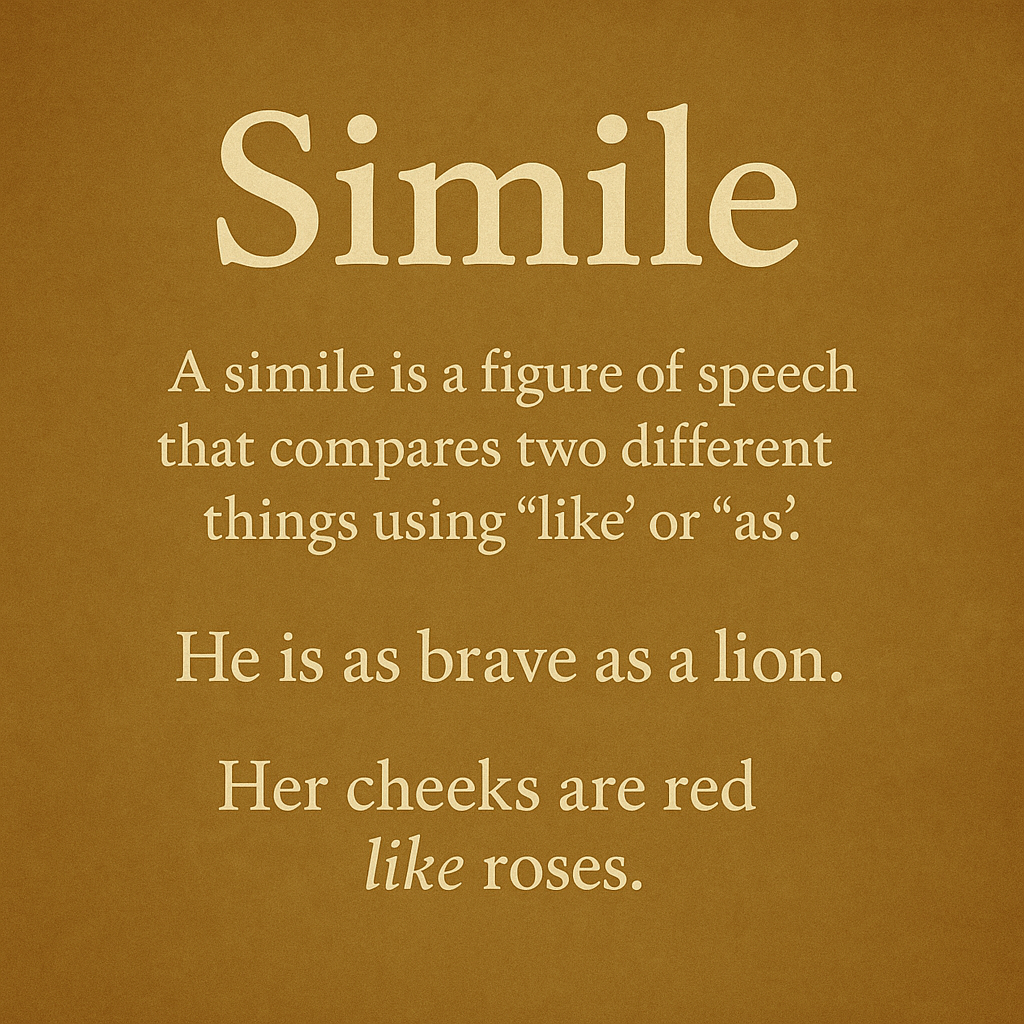Introduction
Simile in literature is a powerful literary device that compares two different things using the words “like” or “as.” Writers use similes to create vivid pictures in the reader’s mind. This comparison helps highlight particular qualities in an imaginative and relatable way.
Similes make writing more descriptive and engaging. They often appear in poems, stories, songs, and even everyday speech. Unlike metaphors, similes clearly show the comparison by using signal words like “like” or “as.”
What Is a Simile?
A simile is a figure of speech that describes something by comparing it to something else using “like” or “as.” These comparisons connect unfamiliar ideas to familiar images. Similes allow readers to better understand characters, settings, and emotions.
Features of Simile in Literature
- Uses “like” or “as” for comparison
- Connects two unlike things
- Creates mental images
- Strengthens emotional effect
- Makes writing poetic and expressive
Famous Simile Examples in Literature
- William Wordsworth – I Wandered Lonely as a Cloud
“I wandered lonely as a cloud that floats on high o’er vales and hills.”
The poet compares his loneliness to a drifting cloud to show emotional distance. - Robert Burns – A Red, Red Rose
“My love is like a red, red rose.”
This simile shows how beautiful and fresh the poet’s love feels. - Emily Dickinson – A Bird Came Down the Walk
“They looked like frightened beads.”
The bird’s eyes are compared to tiny beads, adding precision to the image. - Charles Dickens – A Tale of Two Cities
“The wine was red like blood.”
This simile hints at danger and rising conflict.
Common Everyday Similes
Writers and speakers often use similes to communicate faster and with stronger images. Here are a few familiar examples:
- She was as graceful as a swan.
- He ran like the wind.
- That exam was as tough as nails.
- His words cut like a blade.
- The baby’s cheeks were as soft as silk.
These examples use simple comparisons to express ideas powerfully.
Why Writers Use Similes
Writers use similes to:
- Create clear visual images
- Express emotion quickly
- Add beauty and rhythm to language
- Connect the unfamiliar to the familiar
- Develop characters and tone
For example, when an author says, “His anger burned like fire,” the reader instantly imagines the heat. The reader also pictures the danger and intensity of that anger.
Similes also make writing easier to remember. Readers connect more deeply with writing that paints strong images.
Difference Between Simile and Metaphor
Although both similes and metaphors show comparisons, similes make them explicit with words like “like” or “as.”
- Simile: Her hair flowed like a river.
- Metaphor: Her hair was a river.
Similes are easier to spot because they openly show the comparison.
Final Thoughts on Simile in Literature
Simile in literature enriches language by adding clarity, color, and creativity. Through vivid comparisons, similes help readers see, feel, and experience more. Authors from every era have used similes to give emotional depth and sensory detail to their work.
You will sharpen your understanding of great literature through learning to recognize and use similes. This applies whether you are analyzing poetry, writing essays, or crafting stories.

Mark Twain-Life and Works: https://americanlit.englishlitnotes.com/mark-twain/
Expression of Time, Money and Distance in Grammar:
https://grammarpuzzlesolved.englishlitnotes.com/expressions-of-time-money-distance/
The Camel and the Jackal: https://englishwithnaeemullahbutt.com/2025/05/19/camel-and-jackal/
The History of English Literature: https://englishlitnotes.com/category/history-of-english-literature/
Discover more from Naeem Ullah Butt - Mr.Blogger
Subscribe to get the latest posts sent to your email.
